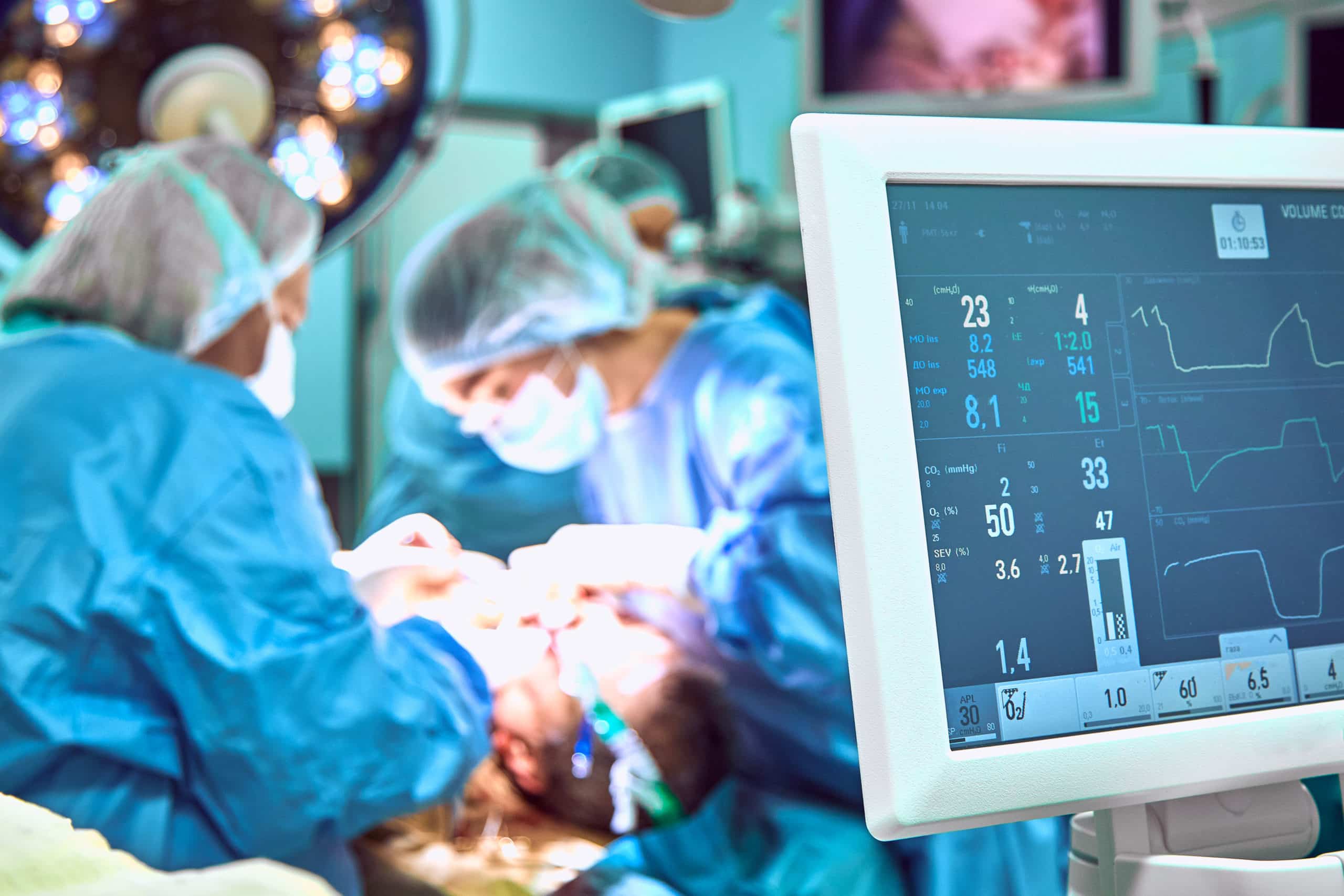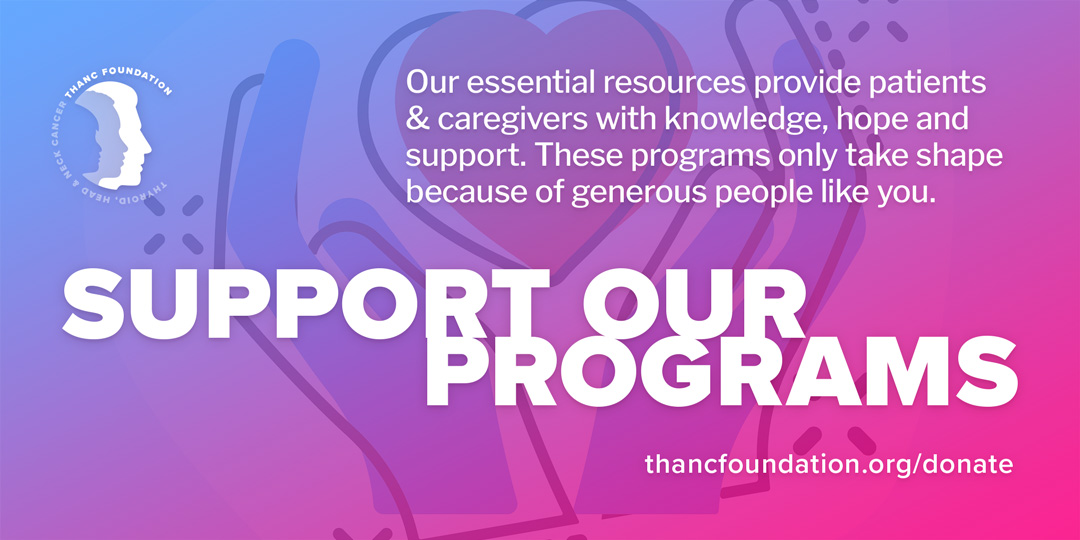The facial nerve controls the muscles of the face. Some parts of the facial nerve are also responsible for controlling tearing, nasal secretions, saliva production, and a portion of taste. The facial nerve begins at the brain stem, travels through the temporal bone and middle ear, and exits the skull just below the ear. Once it exits the skull, it enters the parotid gland, a saliva-producing gland in front of the ear, and splits into a number of branches that control different muscles responsible for moving the face. Therefore, cancers of the parotid gland are one of the most common cancers that invade and cause damage to the facial nerve.
Injury to and/or removal of branches of the facial nerve will result in limited mobility of all or part of one side of a patient’s face, depending on where the injury occurs. Aside from the associated cosmetic issues, drooling and eye issues can occur. For these reasons, if a patient’s facial nerve is resected or damaged as a part of cancer removal surgery, the surgeon might recommend a facial reanimation procedure. Facial reanimation surgery can be divided into two groups—static suspension and dynamic reanimation.
Static Suspension
This involves performing procedures that do not include reinnervation of muscles. The goal of static reanimation is not to give muscles of the face a new nerve supply but to move and/or suspend muscles to improve a patient’s appearance at rest. Examples of static suspension include static slings, eyelid weights, brow lifts, and face-lifts.
Static Sling
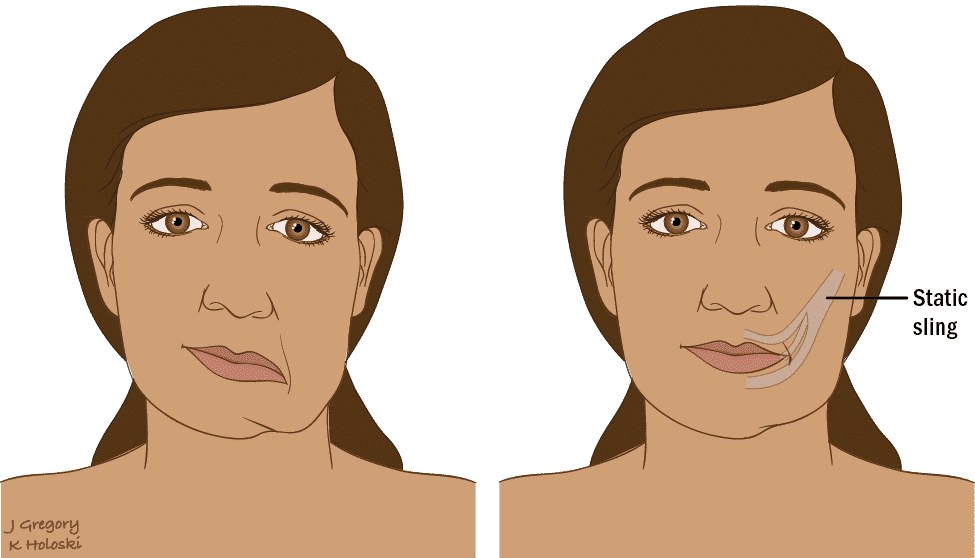
A static sling is considered when one side of a patient’s face, often the corner of the mouth, is drooping, causing obvious asymmetry at rest. A piece of synthetic tissue or tissue taken from the patient, such as fascia from the leg, is sutured to the corner of the mouth and suspended from either the cheek bone or the region just in front of and above the ear. The goal is to pull the corner of the mouth upward and outward, resulting in a more symmetric look at rest and improving any facial droop.
Lip Wedge Excision
A lip wedge excision is considered when the corner of the mouth does not close completely, resulting in drooling when a patient eats. A wedge of the lip is removed and the remaining tissue is sewn together to lift and tighten the corner of the mouth.

Eyelid Weights
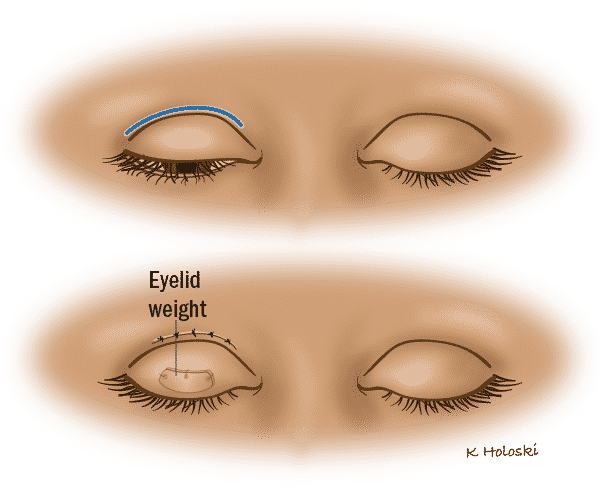
Eyelid weights are considered when the upper division of the facial nerve is affected, resulting in incomplete eye closure. In addition to using artificial tears and lubricants to keep the eye moisturized and prevent corneal drying, a doctor might recommend placement of a gold or platinum weight into the upper eyelid to help it close completely and protect the cornea from drying out. This can be done in the office with local anesthesia or in the operating room with general anesthesia.
Brow/Face-Lifts
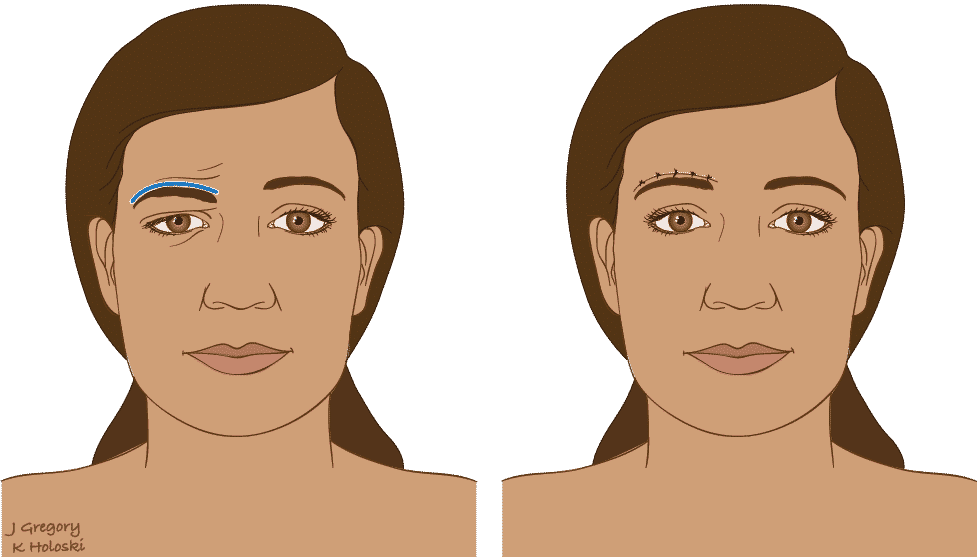
Brow lifts or face-lifts are considered when there is major asymmetry of part of the face at rest. A hidden incision is made either in front of the ear, in the hairline, or near the eyebrow. In each of these lifting procedures, the skin is pulled up and back and any excess skin is removed. The purpose of these techniques is to improve the appearance of a drooping face or brow.
Botulinum Toxin Injections
Botulinum toxin injections (Botox) are considered when the upper branch of the facial nerve is damaged. Botox results in the disappearance of wrinkles on the contralateral side of the face. By having Botox injected into the opposite side of the forehead, a patient might achieve a more symmetrical appearance.
Dynamic Reanimation
This involves bringing in a new nerve supply to select muscles of the face. When a muscle loses its nerve supply, the muscle shrinks over time, resulting in facial deformity. While the ultimate goal of dynamic reanimation is for the patient to have some movement in the injured side of their face, another worthy goal is to prevent the muscles from shrinking to maintain facial tone.
Nerve Grafting
There are a number of ways to suture the ends of nerves together.
- Primary Nerve Repair
If the cut ends of the facial nerve are close together, they can be stitched back together, in a procedure called primary nerve repair. - Cable Graft
Cable grafts involve taking a less important nerve from one part of the body (usually a sensory nerve) and using it as a cable to join two cut ends of the facial nerve in order to achieve dynamic reanimation. - Jump Graft
Jump grafts involve taking a motor nerve from the facial region and connecting it to the cut end of the facial nerve in order to achieve dynamic reanimation. Potential jump grafts can be obtained from the nerve to the masseter muscle, which helps with chewing, or a portion of the hypoglossal nerve, which controls movement of one half of the tongue. If a jump graft is used, the patient will have to re-program how they move their face. For example, if the nerve to the masseter muscle is used as a jump graft, then in order to move the face a patient would need to think about biting down (the normal function of the masseter muscle). Similarly, if the hypoglossal nerve is used, the patient will have to think about moving their tongue in order to get facial movement. This requires practice, but some patients become very skilled at this.
Muscle Transfer Techniques
This involves sewing a muscle that has a nerve supply to the corner of the mouth to achieve movement of the mouth. This can be done with local muscles or as a free flap.
- Local Muscle Transfers
Local muscle transfers are considered in cases of facial paralysis to achieve immediate movement of the face. The temporalis muscle and the masseter muscle are two of the most common muscles that are transferred to the corner of the mouth. When a patient clenches their teeth together, they can get movement of the mouth. This takes practice and training. - Cross Facial Nerve Graft with Free Muscle Transfer
A cross facial nerve graft with free muscle transfer is designed with the goal of achieving symmetric movement of the face that does not require biting down or moving the tongue when smiling. This procedure is done in two stages.
First, a nerve graft is taken from somewhere in the patient’s body (typically a sensory nerve from the leg). One end of this nerve is connected to a small branch of the facial nerve on the contralateral “normal” side of the face, and the other end is tunneled across the face and placed just under the skin on the other side of the face. In the second stage, usually performed months later, a free muscle flap (usually the gracilis muscle from the inner thigh) is removed along with a nerve, artery, and vein and placed into position in the paralyzed side of the face so that when the muscle moves, it will create a smile. The artery and vein of the flap are sewn to an artery and vein in the neck to give the muscle life again, and the nerve from the flap is sewn to the end of the nerve graft that was placed in the previous operation. This overall procedure takes months to complete and has variable final results.
Top Questions for Your Doctor
Access our list of the most important questions to ask your physician at your next appointment.

